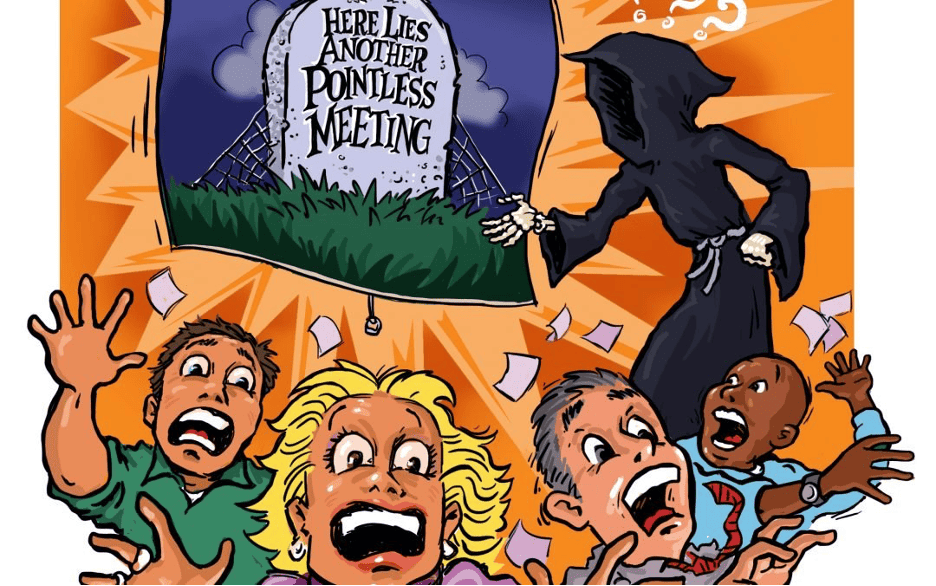How to Facilitate A Meeting
We’re poking fun at scary meetings. As an extra treat, we’re sharing some tricks of the trade on facilitating a meeting that drives greater value for participants. As we’re seeing a shift in how we meet and more reliance on digital tools for meetings, let’s hope that scary meetings can finally rest in peace.

The Scary Facts About Meetings
Much can be said about the typical meeting, and much of it isn’t good.
Here’s a question for you: what’s the value of a meeting?
Meetings are meant to drive productivity in the workplace. There’s a lot of value in getting people together, focused on the same thing and thinking through issues to keep work moving forward and achieve the goals and objectives of the organization.
The challenge is, most meetings are scheduled without much thought. They become placeholders in your calendar with an assumed obligation to show up, often without clarity of what’s expected of you and what’s going to happen.
Doing a little research on the web, I came across some scary facts about unproductive meetings. Not surprisingly, they waste money and suck up time. Unproductive meetings are estimated to cost more than $37M USD annually. While most people I know see time as a scarce resource, they keep agreeing to attend meetings that are wasting their time.
These facts are positively ghoulish:
- About 15% of an organization’s collective time is allocated to meetings
- Middle managers spend 35% of their time in meetings
- Senior managers spend 50% of their time in meetings and consider 69% of meetings to be failures
- Generally, we spend 4 hours a week – 10% of the average work week – preparing for status update meetings, which aren’t necessarily productive!
You might also be interested in: How to Collaborate if Your Team is Hybrid
How to Facilitate a Meeting
In our experience, three factors contribute to unproductive meetings:
- A lack of planning and structure to get the right people focused on the right things and making good use of time
- People showing up and not being present (i.e., multi-tasking and allowing distractions)
- Using meeting technologies and approaches that impede engagement and efficiency.
So, we offer three things you can do to facilitate a better meeting.

1Plan for Productivity
Most meetings are scheduled without much thought to what needs to be finalized, who needs to be there, and the thinking or sharing that needs to be accomplished.
What needs to happen in your meeting? Are you sharing information? Do you need a creative discussion where people are expected to come up with ideas or help to solve a problem creatively? Or is this a meeting where decisions will need to be made?
2Be Present and Accountable
Here’s the trick. Participants share a responsibility for making meetings productive. Participants must understand their reason for being at the meeting; at a minimum, it’s to contribute and receive value. You can’t contribute or receive value if your mind is focused on your device, thinking about your last or next meeting, or multitasking.
Ensure everyone understands their role and responsibilities to the meeting and set ground rules for participation. And, unless you’re working in a life-or-death environment, everyone can likely move away from their devices for the duration of the meeting. It’s okay to ask people to put them away, place them on silent and give the meeting participants respectful attention.
I like to use three roles in meetings.
- Facilitator – the person responsible for leading the group through the meeting process.
- Client – the person responsible and accountable for the work of the team. This is the person who holds decision-making authority in the meeting.
- Resource Group – the people invited to participate and contribute thinking. These people can inform decisions but don’t make them.
3Make it Easy to Engage
Here’s the trick: video conferencing.
A recent Harvard Business Review article explains how video conferencing makes team meetings all the more productive. If you’ve got team members who need to dial in, ensure it’s through a video conferencing tool. When you can see the whites of their eyes, remote participants engage more.
As the strategic meeting facilitator, you must actively check in with connected participants to ensure they can contribute to the meeting.
Here’s a trick: Make a list of everyone on the call. At the start of the meeting, tell everyone you will be circling through them for input at regular intervals. This keeps people on their toes and ensures their voices get a place in the meeting.
Meetings that need input from remote participants need more than video conferencing. New approaches must capture ideas and insights if your session includes creative discussion.
If you’re running a meeting where you need to facilitate a large group of people and you need high participation, here’s another trick – it’s a digital facilitation tool called Stormz. We’ve helped many clients integrate its use in team meetings and special meetings for creative problem-solving, community consultation and other meetings. A cloud-based application, Stormz allows everyone to contribute ideas and insights into specific topics without the need for Post-it® Notes. The data collected is available in real-time to everyone in the meeting and can immediately be reported on after the meeting with the click of a button.
Meetings don’t need to be scary. Our clients tell us we help them make meetings a real treat.

Looking to improve your meeting facilitation?
We can help. If you:
- Need help designing or facilitating a team meeting,
- Need a strategic planning facilitator,
- Want to engage stakeholders in strategic planning, problem-solving, decision-making, project management, or work planning, or,
- Need a facilitator for your next executive retreat, all-staff, town hall or community meeting, don’t hesitate to schedule a consultation call.


